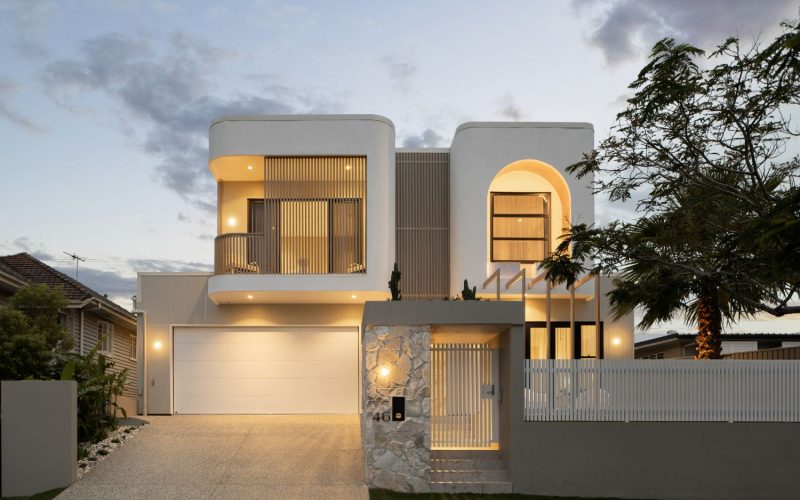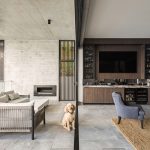Finding the right builder for your dream home or renovation can be daunting, but essential for a successful project
Words Kylie Baracz
Closing your eyes, you can visualise it — your ideal home. You can picture your hand reaching to open your new front door, feeling the joy and peace washing over you, finally living your dream. Yet, when you open your eyes, you’re faced with a blank slate, primed and ready for your new project.
Finding the right builder who will see your dream the way you do and execute it to perfection can seem daunting. Where do you start? How do you know if you’ve found the right one?
Before you go hunting, you need to complete an essential first step — defining the scope of your build.
Define your project scope
A clear project scope and goal will help you find the right builder for your home. Different builders are available for different needs. General builders can execute all builds, while specialists work on builds of a certain design, such as heritage restoration, luxury modern homes, or modular projects.
Understanding the scope of your renovation project will help you narrow your search for the ideal builder. Write bullet points, such as a wish list, on what you want your build to feature so you can discuss it with your potential builder.
“We recommend disclosing the budget along with a ‘must-haves’ and ‘nice-to-haves’ list,” says Ben Tass, director of Tass Construction Group. “That way, the builder can assist with the value engineering component of the project, which is becoming more and more common.”

Maree O’Shea, creative director at O’Shea & Sons Builders, agrees and says the first step should be securing finances. “The owners’ borrowing capacity has a big impact on the type and cost of a new home or major renovation,” says Maree. “Some early conversations on their ideas with a local builder will go a long way towards understanding if their available finances
will be sufficient.”
Ben recommends early contractor involvement to ensure the architect/designer’s design is within budget. The project should always be a collaboration between designers and builders and ideally undertaken before plans are lodged with the council.
Do your research
Recommendations from family, friends and neighbours are a great way to find reliable, skilled builders who can work on your home project. Another way, however, is to take advantage of 21st-century technology and head online.
Websites such as Houzz, Hipages or ArchiPro feature builder profiles that include their home project portfolios. Ensure the builders are accredited by industry associations such as the Housing Industry Association (HIA) or Master Builders Association (MBA). “It’s paramount that clients have done their research on builders, including looking for award-winning, good reviews, testimonials, similar built projects, and years in business,” says Ben.
Visiting recently renovated homes in your area similar to your build design (through open homes) could also help you choose as you see their work first-hand, up close. “In Brisbane, there is a great facility called The Build & Design Centre,” says Maree. “Here, there’s an array of product exhibitors, consumer events, and also information provided on local builders
who are associated with the centre.”

Look out for red flags
Besides ensuring they have the correct licencing, accreditations, certifications and insurance, you must choose a builder with detailed experience in projects like yours. These include a Contractor Licence/Supervisor Certificate, an ASIC report, a builder licence number, and insurance coverage (HBCF and Public Liability). Red flags to watch out for include:
- A lack of transparency
- No scope of works or references with little detail
- Low quotes that don’t feel right
- Wanting to do cost plus but can’t provide fixed pricing
- Not providing value engineering options or assisting in the early stages
- Lack of contractual arrangements or shady tactics such as splitting the contract into multiple scopes
- Not having a dedicated team onsite every day
- Not providing guarantees such as completion times, etc
- Too many provisional sums or a list of unknowns which could be determined before starting
- Wanting to rush the commencement of the project without going through and finalising everything

Maree says it is a major red flag if the deal looks too good to be true. Discounted and low-cost quotes compared to other builders generally mean the builder is cutting costs, and consequently there’s a risk the owner will be hit with unforeseen costs, or worse still, the builder could go into administration.
Meeting the builder in person can help, as sometimes you must go with your gut feel when speaking with them. “It is very important to have a preliminary meeting so that you can see if there is an effective connection,” says Maree. “It is equally mportant for the builder to connect with the homeowner as it is for the homeowner to trust the people who will be working on their dream home for many months.”
Questions to ask builders
Asking the right questions of builders can give you an idea of whether they are the right fit for your build, and if you feel comfortable working with them. “A list of important questions, which is individual to each client, should be written and ready, including timeframes of projects and lead times before starting,” says Ben.

Key questions you should be asking your potential builder during your initial meetings are:
- What is your past project experience?
- What is your estimated timeline for the build? (It’s also worth finding out about their project management approach.)
- When can you start the build?
- How have you handled unexpected issues, delays or extra costs incurred during a build?
- How have you overcome them?
- How frequently will you visit the site?
- What is the payment schedule?
- What assurances are in place so you don’t go into administration?
It is essential to build a good rapport with your builder and establish open communication. Maree recommends considering these three key elements when meeting with your builder: relationship, reliability and reputation. Choose a professional builder who is attentive to detail, punctual and responsive.
Meeting with at least three different builders to compare their quotes and communication styles is ideal. “Homeowners need to be aware that once they sign a contract, they hand over the possession of the property to the builder,” suggests Maree.
Working with your builder
The time frame for a build will depend on the site conditions, the renovation needed, or the size of the home to be built. Generally, a custom home build will take nine to 18 months to complete, with three to six months to go through the statutory regulation process. Renovation timelines can vary much more, with the average range for major renovations being four to nine months.
The most important milestones of your build will often depend on the complexity of the site and construction. However, some key build stages, such as breaking ground, are worth noting. To achieve these critical milestones, on-site communication is essential. This can be done simply by having daily phone calls with your builder or using sophisticated software that can keep you updated with your home’s progress.
“The builder’s management system should be the primary avenue for communication, variations and progress,” says Maree. “A good builder will want to involve the homeowners in planning, designs and selections. By the time the build commences, almost everything should already be determined and documentation final.”
Ben says cohesion, transparency and communication are paramount in the planning and execution stages. “It’s all in the planning. If you get that right and have everything documented and discussed on the front end, the execution is the easy part!”
Planning regulations
Planning and statutory regulations can vary from location to location, so knowing the rules in the area where you want to build is essential. An experienced builder should be able to help you with this.
Ben says that there are two main pathways: DA and CDC. “CDC is a much simpler process, and approval can be given in a few weeks via a certifier,” says Ben. “The best way to describe this is if the owner can tick off a bunch of items from a standardised checklist and play within all the rules and regulations, they can get approval via this pathway.”
DA is a more complicated approval process, although it is more common. The approvals take three to six months and are assessed by the council.
Find more of Ben Tass’s projects at tass.com.au and Maree O’Shea’s custom builds at osheabuilders.com.au
This article was originally featured in Home Design 27.2.












